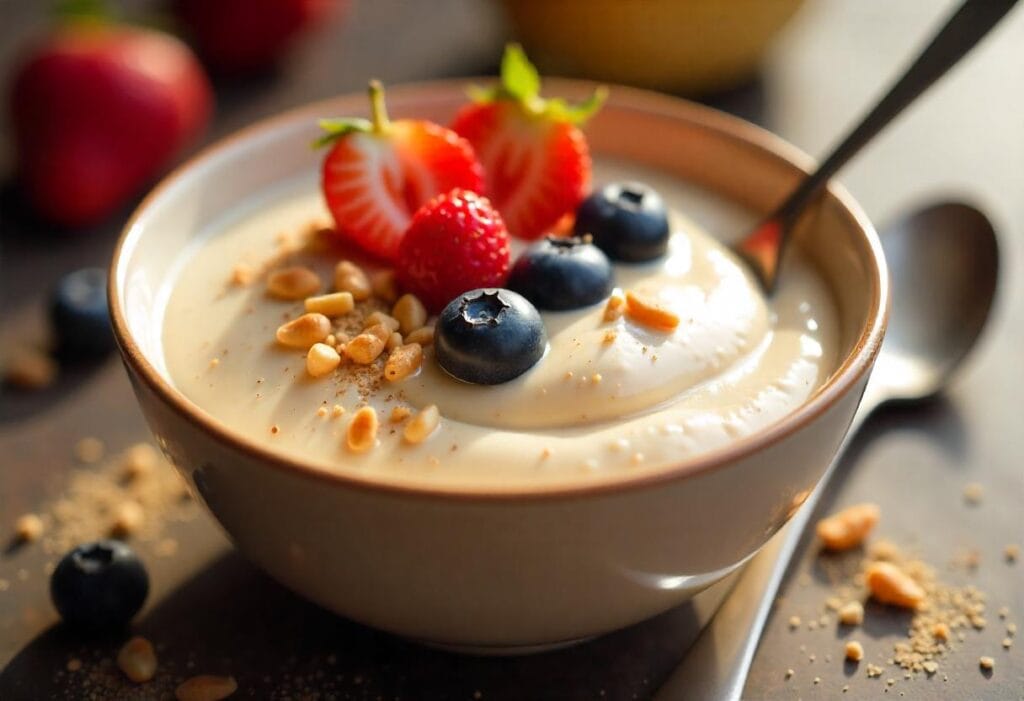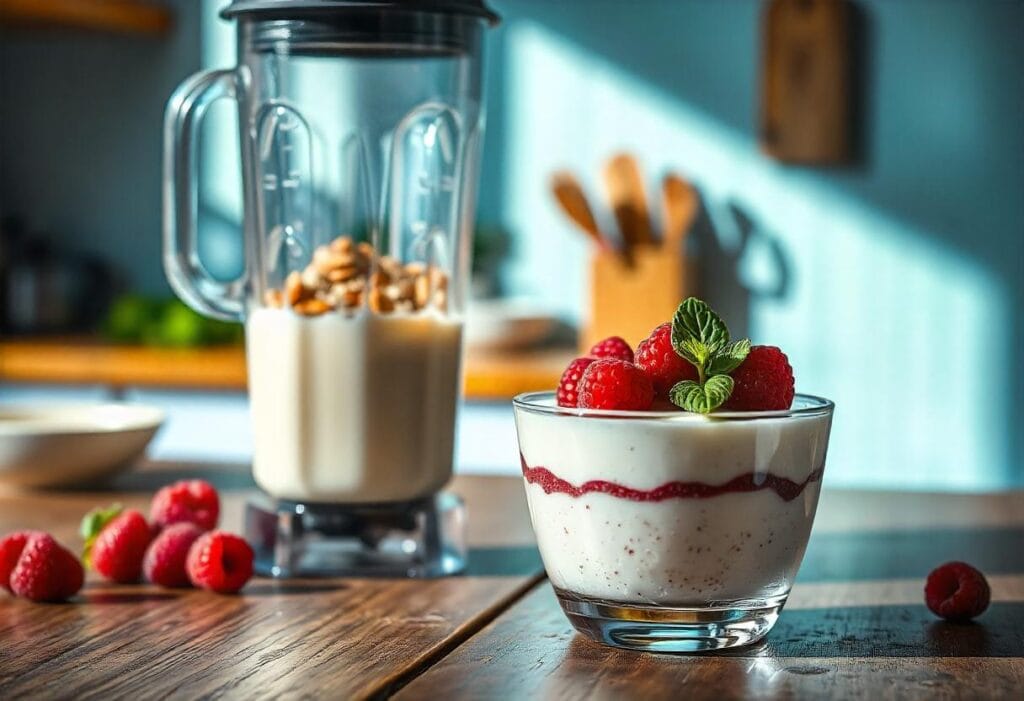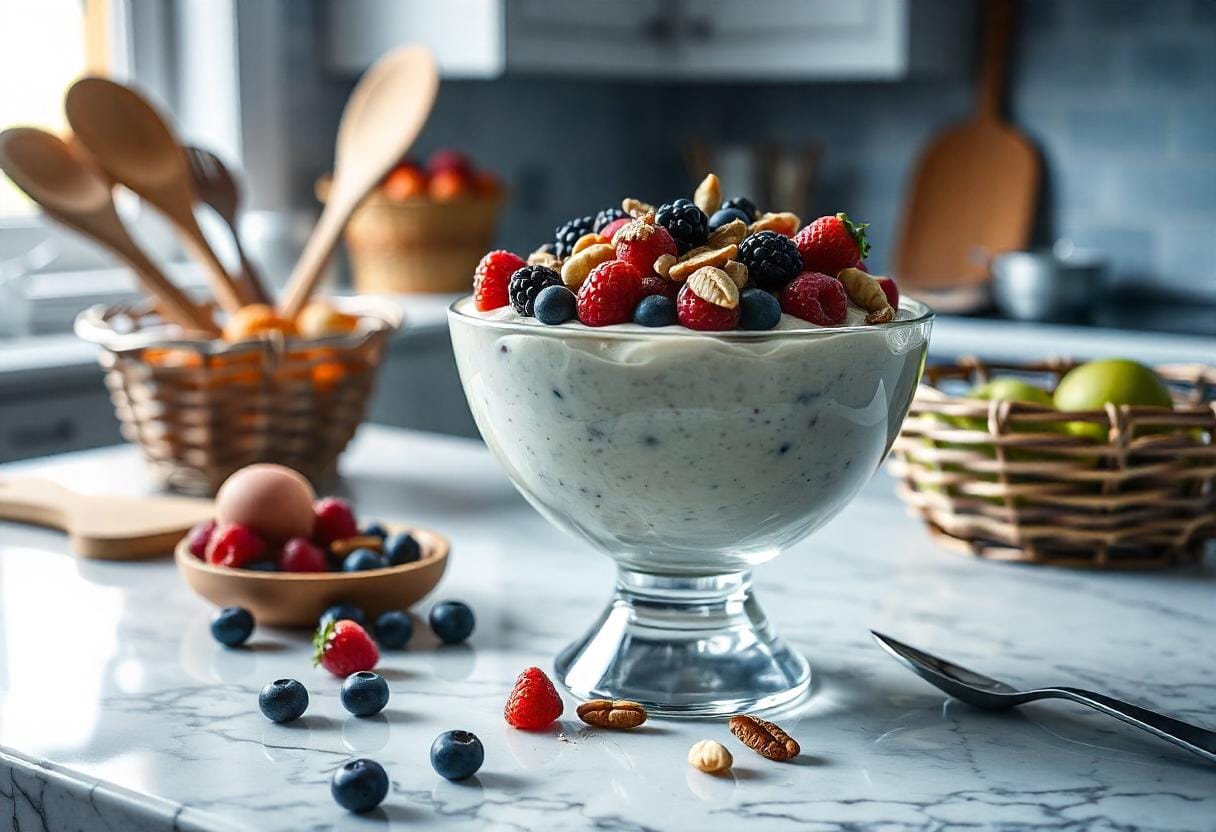Protein puddings are everywhere these days! From gym-goers to those just looking for a healthier dessert option, protein puddings have quickly become a favorite snack. But the real question is: Are protein puddings healthy Can they really be a part of your daily diet without compromising your health? In this article, we’ll dive into the health benefits, concerns, and everything you need to know about protein puddings. Let’s uncover the truth behind this creamy, protein-packed treat! 😋
Introduction: The Growing Popularity of Protein Puddings
Protein puddings have surged in popularity over the past few years. They’re marketed as healthy, high-protein snacks or desserts that can be enjoyed by anyone—from athletes to people just trying to eat a little better. But, like anything trendy, they often raise questions: Are they as healthy as they seem? Can they really fit into a balanced diet? And how do they compare to other dessert or snack options?
In this article, we will explore all these questions, clear up any confusion, and provide you with everything you need to make an informed decision about adding protein pudding to your diet.
What Are Protein Puddings?
Simply put, protein puddings are sweet, creamy desserts made by blending protein powder with liquids and other ingredients like sweeteners, flavorings, and sometimes thickeners. They can be made with whey protein, plant-based protein, or other forms of protein powder. Protein puddings are a great way to get an extra protein boost while indulging in a tasty treat. They’re smooth, rich, and often low in sugar compared to traditional puddings, making them a healthier alternative for those looking to increase their protein intake without the extra calories.
But, as with any food, it’s important to understand what goes into your protein pudding to determine if it’s actually healthy.
Why Are People Turning to Protein Puddings for Health and Nutrition?
People are increasingly turning to protein puddings for various reasons, most of which are tied to the health benefits of protein itself. Protein is a crucial macronutrient that supports muscle growth, aids in tissue repair, boosts metabolism, and helps keep you feeling full longer. So, by adding protein powder to a pudding, you’re combining the benefits of protein with a sweet, satisfying dessert.
Protein puddings are also a great option for anyone looking for a quick snack that packs both nutrition and flavor. Plus, you can customize them based on your specific dietary needs—whether you’re trying to lose weight, build muscle, or simply enjoy a healthy dessert.
The Health Benefits of Protein Puddings
So, are protein puddings healthy? To answer this, let’s explore some of the key benefits they provide:
High-Protein Content: Why It Matters for Your Health
Protein is a powerhouse nutrient. It’s involved in building and repairing tissues, producing enzymes and hormones, and maintaining a healthy immune system. For adults, protein also plays a major role in muscle maintenance and growth.
In fact, when you consume protein, it gets broken down into amino acids, which help build muscles and tissues. The high protein content of protein puddings makes them an excellent choice for those looking to boost their daily protein intake.
But it’s not just about muscle growth. Protein also helps with:
- Supporting metabolism: Eating enough protein helps your body burn more calories by increasing the thermic effect of food (TEF).
- Regulating blood sugar: Protein helps slow the absorption of sugar into your bloodstream, which can prevent energy crashes and spikes in blood sugar.
- Boosting satiety: Protein is filling, meaning it can curb hunger and help you feel satisfied longer, which can assist with weight management.
So, yes, protein puddings can definitely be a healthy option when you’re looking to get more protein into your diet.
Weight Management: How Protein Puddings Can Help You Feel Fuller Longer
If you’ve ever felt that 3 p.m. slump and reached for a sugary snack, you know that a quick sugar rush often leads to another crash. This is where protein puddings shine. Because protein takes longer to digest, it helps keep you feeling fuller longer, preventing overeating.
When you include protein-rich foods like protein pudding in your diet, it can reduce your overall calorie intake by curbing cravings and keeping your appetite in check. And because protein is involved in muscle-building, the more muscle you have, the higher your metabolism becomes. So, if you’re aiming for weight management or fat loss, protein puddings can be a great snack or dessert option that helps you stay on track without starving or feeling deprived.
Muscle Building and Recovery: The Role of Protein in Fitness
For athletes and gym-goers, protein is essential for muscle repair and recovery. After a workout, your muscles experience small tears that need to be repaired with protein. This is where protein puddings come in: they offer an easy, delicious way to refuel your body with the protein it needs to repair and grow stronger.
Whether you’re lifting weights, running, or doing any form of intense exercise, having a protein-rich snack like protein pudding after your workout can help speed up recovery and improve muscle growth.
“Protein is the building block of muscle. Without it, your muscles can’t grow and recover after a workout.” 💪
Skin, Hair, and Bone Health: The Lesser-Known Benefits of Protein Puddings
While we often think of protein for muscle repair, it also plays a role in maintaining healthy skin, hair, and bones. Collagen, a form of protein, is crucial for maintaining the elasticity of your skin and strengthening hair and nails. By consuming protein puddings, you’re supporting collagen production and helping your body stay strong and youthful. Additionally, protein helps maintain bone health by supporting the production of bone tissue and promoting mineral absorption.
Common Protein Pudding Ingredients: Are They Healthy?
Now that we’ve discussed some of the health benefits of protein puddings, let’s look at the ingredients that typically go into these treats. After all, the healthiness of any dish depends on the quality of its ingredients. So, are the common ingredients in protein puddings healthy?
Protein Powders: Whey vs. Plant-Based vs. Casein
One of the most important ingredients in protein pudding is, of course, the protein powder. There are several types available, including:
- Whey Protein: A fast-digesting protein that comes from dairy. It’s ideal for post-workout recovery, but not suitable for those who are lactose intolerant or follow a vegan diet.
- Plant-Based Protein: Derived from plants like peas, hemp, soy, or rice. It’s a great option for vegans or anyone who wants to avoid dairy.
- Casein Protein: A slow-digesting protein, often used before bedtime because it provides a steady release of amino acids while you sleep.
Each type of protein has its benefits, and choosing the right one depends on your dietary needs, lifestyle, and fitness goals.

Sweeteners in Protein Puddings: Are They Healthy?
Many protein pudding recipes rely on sweeteners to enhance the flavor. The sweetener you choose can significantly impact the healthiness of your pudding. Here are some common options:
- Natural Sweeteners: Stevia, monk fruit, and erythritol are popular low-calorie, natural sweeteners. They don’t spike blood sugar, making them great for those on low-carb diets.
- Artificial Sweeteners: While sugar substitutes like aspartame or sucralose may reduce calorie intake, some studies have raised concerns about their long-term effects on health. If you’re looking for a clean option, it’s best to stick with natural sweeteners.
- Sugar: While sugar adds sweetness, it also adds unnecessary calories. If you’re trying to keep your pudding healthy, opt for a minimal amount or use alternatives like honey or maple syrup in moderation.
Dairy vs. Non-Dairy: Which Is Better for Your Health?
When it comes to making protein pudding, many recipes call for dairy-based ingredients like milk or yogurt. While these ingredients offer some health benefits (such as calcium for strong bones), they’re not suitable for everyone. Some people are lactose intolerant or follow a vegan diet, in which case, non-dairy options like almond milk, coconut milk, or oat milk are better alternatives.
« Non-dairy milk options are an excellent choice for anyone with lactose intolerance or those looking to avoid dairy. » 🌱
Choosing between dairy and non-dairy options is a personal choice. Both can be part of a healthy diet, but it’s important to choose one that works for your body and dietary preferences.
Are Protein Puddings a Good Option for Weight Loss?
If you’re trying to lose weight, protein puddings can be a helpful part of your plan. Let’s take a closer look at how protein puddings can aid in weight management and whether they’re a good option for those trying to shed some pounds.
How Protein Aids in Weight Loss
Protein helps with weight loss in several ways:
- Satiety: Protein makes you feel fuller for longer, reducing the likelihood of overeating or snacking between meals.
- Thermic Effect: Protein requires more energy to digest than carbs or fats, which can help boost your metabolism and burn more calories.
- Preserving Muscle Mass: When you’re losing weight, you want to ensure that the weight loss is mostly fat, not muscle. Protein helps preserve lean muscle mass, which can prevent a drop in metabolism.
For those on a calorie-restricted diet, protein puddings can be a great snack that satisfies your sweet tooth without adding a ton of empty calories.
The Calorie Count: Does Protein Pudding Fit Into a Weight Loss Plan?
While protein puddings can be a healthy choice, it’s important to keep an eye on the calorie content, especially if you’re trying to lose weight. Some protein puddings, especially those made with high-calorie sweeteners, creamy milk, or lots of toppings, can end up being quite calorie-dense. To keep your pudding weight-loss-friendly, opt for lower-calorie ingredients and control your portion sizes.

Nutrition Facts for a Basic Protein Pudding (Per Serving):
| Nutrient | Amount |
|---|---|
| Calories | 180 |
| Protein | 25g |
| Carbohydrates | 12g |
| Fat | 6g |
| Fiber | 3g |
| Sugars | 5g |
Frequently Asked Questions (FAQ) About Protein Puddings
As protein puddings continue to rise in popularity, many people have questions about them. From concerns about digestion to confusion over ingredients, let’s address some of the most common questions people have about protein puddings and their health benefits.
Can Protein Puddings Help with Muscle Growth?
Yes! Protein puddings are a great option for those looking to build muscle. The primary role of protein is to help repair and grow muscle tissues, especially after workouts. When consumed post-workout, protein pudding provides the necessary protein to help your muscles recover and grow stronger. So, if you’re trying to build muscle or just want to support recovery after exercise, protein pudding can be a tasty and effective addition to your diet.
Are Protein Puddings High in Sugar?
Not necessarily. The sugar content of protein puddings largely depends on the ingredients and the sweeteners you use. Many store-bought protein puddings can contain added sugars or artificial sweeteners, which can be unhealthy if consumed in large quantities. However, when making your own at home, you can control the sweetness and opt for natural, low-calorie sweeteners like stevia, monk fruit, or erythritol, which won’t spike your blood sugar.
If you’re looking for a healthy option, always check the label when buying pre-made protein puddings, or simply make your own with clean ingredients.
Can Protein Pudding Be Made Without Protein Powder?
Yes! While protein powder is commonly used in most protein pudding recipes, it’s not the only way to make a protein-rich dessert. You can substitute protein powder with other protein-rich ingredients like Greek yogurt, cottage cheese, or silken tofu. These ingredients can provide the same amount of protein and create a creamy, pudding-like texture.
For example, if you prefer a dairy-based option, Greek yogurt is an excellent alternative and provides both protein and probiotics for gut health.
Can Protein Puddings Be Part of a Weight Loss Plan?
Absolutely! Protein puddings can actually aid in weight loss. High-protein snacks are known to help with satiety, meaning they keep you feeling fuller for longer, which can reduce overall calorie intake. Since protein also boosts metabolism, it can help support fat loss while maintaining lean muscle mass.
If you’re watching your calorie intake, opt for a low-calorie protein pudding recipe with clean ingredients. Avoid high-sugar or high-fat add-ins, and watch your portion sizes to make sure you’re staying within your desired calorie count.
Are Protein Puddings Suitable for Vegans?
Yes! There are many plant-based protein powders available, including pea, rice, hemp, and soy protein. These protein powders are perfect for vegans, and you can make your protein pudding dairy-free by choosing non-dairy milks like almond, coconut, or oat milk. Many plant-based protein puddings are just as creamy and delicious as their dairy counterparts, making them a great option for those following a vegan diet.
Can Protein Pudding Cause Digestive Issues?
For some people, consuming too much protein at once can lead to digestive issues such as bloating, gas, or discomfort. If you’re sensitive to certain proteins, like whey or dairy, you might experience these symptoms after eating protein puddings. To avoid digestive discomfort, try using a protein powder that’s easy to digest (such as plant-based protein) or consume smaller portions at a time.
Additionally, ensure that you’re drinking plenty of water when consuming protein to aid digestion.
Conclusion: Should You Include Protein Pudding in Your Diet?
Protein puddings can be a healthy addition to your diet, but only if you make the right choices. These delicious treats provide a great source of protein. Protein helps with muscle growth, weight management, and overall health. They’re easy to customize to fit different diets. Whether you follow a vegan diet, keto plan, or just want a healthy snack, protein puddings are versatile.
Making protein puddings at home allows you to control the ingredients. This way, you can avoid sugar overload and choose healthy options. Protein puddings work well as a post-workout snack, a satisfying dessert, or even a quick meal.
However, moderation is key. While protein puddings are healthy, keep portion sizes in mind. Watch the ingredients you add, especially sweeteners, as they can change the nutritional profile of your snack.
In conclusion, protein puddings are a tasty and nutritious option. When made right, they can help support your fitness and health goals. So, go ahead and make protein pudding a regular part of your routine. Enjoy the flavors and benefits without guilt! 😊

